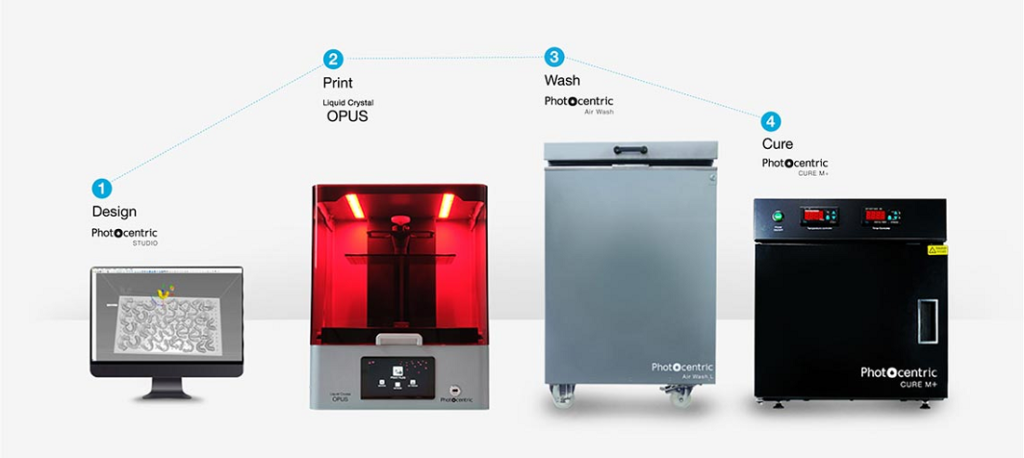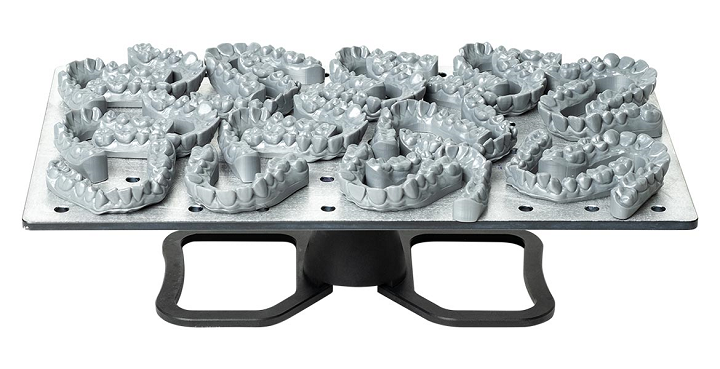Founded in Peterborough in 2002, Photocentric has grown far beyond its humble beginnings in a small room. The company essentially invented liquid crystal display, or LCD, 3D printing, which is a low-energy, scalable, visible light alternative to UV-based 3D printers, and now also has a US location in Arizona, as well as its original home in Cambridgeshire, UK. The award-winning company not only develops specialist resins but also manufactures LCD 3D printers, and has just introduced its most recent LCD system, the rugged LC Opus. The new 3D printer, which Photocentric calls its quickest LCD system to date, will have its official global launch at the International Dental Show in Cologne later this month.
“We wanted to build a versatile printer that was easy to use and delivered great performance and I believe that we have achieved this. It provides customers with a speedy, simple and versatile solution that is equally at home in a dental laboratory as it is in an engineering workshop,” Sally Tipping, Sales Director for Photocentric, stated in a press release. “Its intuitive and simple operation makes LC Opus perfect for both beginners and experienced users alike across a broad range of applications. With its fast cure speed, low running costs and impressive build volume, LC Opus is an excellent all-rounder.”
Photopolymerization specialist Photocentric holds patents in visible light curing AM technologies, and its newest LCD 3D printer works through a simple workflow, starting with loading CAD files into Photocentric STUDIO and preparing them for printing, which takes place on the LC Opus. The printed parts are then washed to remove any excess resin, before they’re finally cured in the last step before use.
The company says that its LC Opus is fast, reliable, and accurate, able to achieve a repeatable performance and featuring a unique design with a custom monochrome 4k LCD screen. Thanks to even light distribution, the printer offers a uniform cure, and its patented Vat-Lift peel release technology means that large surface area printing can be more reliable. The LC Opus can run for longer periods of time at high temperatures, thanks to its efficient and super-quiet PWM fans, and quiet, smooth operation is also helped along by the printer’s Trinamic motor drivers. Made out of aluminum and solvent-resistant paint, the LCD system should be ready to print right out of the box, as it comes pre-calibrated.
With a build volume of 310 x 174 x 220 mm, the 38 kg LC Opus could be used as either a desktop or workbench printer, and Photocentric also says that its new system is extremely durable, thanks to a newly developed double-sealed, long-life vat with handles and tough annealed plastic hood, which is resistant to cracking from chemical exposure. In addition, depending on the resin you use, the LC Opus can supposedly reach fast cure speeds of up to two seconds per layer at 50µm layer thickness.
Additional tech specifications include:
- XY resolution of 81µm
- Precision-engineered THK linear rails
- High-quality 7″ touchscreen
- Vibration damping rubber feet on base
- 18 mm per hour print speed
- 5mW/cm² light output intensity from LCD screen
- WiFi, Ethernet, and USB 3.0 connectivity
While the LC Opus, which replaces Photocentric’s LC Dental, is obviously a great fit for the dental industry, it could also be used for many other applications in various environments. The new 3D printer has begun production at the company’s Peterborough headquarters, and has broken all pre-order records for the other eight Photocentric 3D printer models manufactured in the UK. Printer models will be shipped in Q3, starting in September 2021. You can see the new LC Opus 3D printer for yourself at IDS 2021, Hall 3.1, Stand M011, from September 22-25.
Subscribe to Our Email Newsletter
Stay up-to-date on all the latest news from the 3D printing industry and receive information and offers from third party vendors.
Print Services
Upload your 3D Models and get them printed quickly and efficiently.
You May Also Like
Consolidation in AM: How 2025 Is Shaping the Industry’s New Normal
The first half of 2025 has been marked by a clear shift in the additive manufacturing (AM) industry. Companies are no longer just focused on developing new tech by themselves....
Etsy Design Rule Change Reduces Selection of 3D Printed Goods
Online marketplace Etsy has implemented a rule change requiring all 3D printed goods on the site to be original designs. The update to the site’s Creativity Standards states, ¨Items produced using...
U.S. Congress Calls Out 3D Printing in Proposal for Commercial Reserve Manufacturing Network
Last week, the U.S. House of Representatives’ Appropriations Committee moved the FY 2026 defense bill forward to the House floor. Included in the legislation is a $131 million proposal for...
Transforming From Tourist to Native: Duro CEO Michael Corr Explains Why the Company Rebuilt its PLM Software on AI
In these early innings of the AI boom, many market analysts have expressed concern that AI spend has gotten too far ahead of the technology’s proven ability to deliver significant...



































